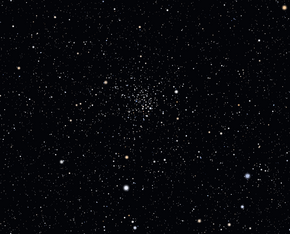
Summary
NGC 6939 is an open cluster in the constellation Cepheus. It was discovered by William Herschel in 1798. The cluster lies 2/3° northwest from the spiral galaxy NGC 6946. The cluster lies approximately 4,000 light years away and it is over a billion years old.
| NGC 6939 | |
|---|---|
 NGC 6939 | |
| Observation data (J2000 epoch) | |
| Right ascension | 20h 31m 30s[1] |
| Declination | +60° 39′ 42″[1] |
| Distance | 3,860 ly (1,185 pc[2]) |
| Apparent magnitude (V) | 7.8 [1] |
| Apparent dimensions (V) | 7' |
| Physical characteristics | |
| Estimated age | 2.2 billions years[2] |
| Other designations | Melotte 231 |
| Associations | |
| Constellation | Cepheus |
Observation edit
NGC 6939 is located near the border of the constellations Cepheus and Cygnus, at the southwest corner of Cepheus. The open cluster is located two degrees southwest of Eta Cephei and 2/3° northwest from the spiral galaxy NGC 6946, which has visual magnitude 8.7. They appear as two patches of haze with 10x50 binoculars. NGC 6939 can be seen and glimpsed with 7x35 binoculars where as 25x200 binoculars are required to start resolve the cluster.[3] The cluster can be glimpsed with 4 inches telescope and is resolved at x72 magnification. NGC 6939 is included in the Herschel 400 Catalogue.[4]
Characteristics and info edit
NGC 6939 is an old open cluster, located 400 parsec above the galactic plane and 8.400 parsec away from the galactic centre and 5.9099 parsec form cygnus.[5] With the use of photometric studies, the age of the cluster was estimated to be between 1,0 and 1,3 billion years!, using as sample 638 stars within the field. The metallicity of the cluster is slightly subsolar[6] (-0.19±0.09).[7]
Some of its members are variable stars: a study in 1998 led to the discovery of six variable stars among the red giants of the cluster, with two of which are Algol type and V466 Cephei appears to be a W Ursae Majoris type. A further study in 2004 identified further 10 variables near the cluster, five of which were W Ursae Majoris type and one RR Lyrae.[8]
References edit
- ^ a b c "NGC 6939". SIMBAD. Centre de données astronomiques de Strasbourg. Retrieved 2015-06-19.
- ^ a b WEBDA: NGC 6939
- ^ Crossen, Craig; Rhemann, Gerald (2004). Sky Vistas Astronomy for Binoculars and Richest-Field Telescopes. Vienna: Springer Vienna. p. 74. ISBN 978-3709106266. Retrieved 18 July 2017.
- ^ O'Meara, Steve (2007). Steve O'Meara's Herschel 400 observing guide : how to find and explore 400 star clusters, nebulae, and galaxies discovered by William and Caroline Herschel. Cambridge: Cambridge university press. p. 275. ISBN 978-0521858939. Retrieved 18 July 2017.
- ^ Jacobson, Heather R.; Friel, Eileen D.; Pilachowski, Catherine A. (September 2007). "Na, Al, and O Abundances of Open Clusters NGC 7142, NGC 6939, and IC 4756". The Astronomical Journal. 134 (3): 1216–1230. Bibcode:2007AJ....134.1216J. doi:10.1086/520927. S2CID 122523181.
- ^ Andreuzzi, Gloria; Bragaglia, Angela; Tosi, Monica; Marconi, Gianni (February 2004). "Photometry of the intermediate-age open cluster NGC 6939". Monthly Notices of the Royal Astronomical Society. 348 (1): 297–306. arXiv:astro-ph/0311249. Bibcode:2004MNRAS.348..297A. doi:10.1111/j.1365-2966.2004.07366.x. S2CID 14941596.
- ^ Friel, Eileen D.; Janes, Kenneth A.; Tavarez, Maritza; Scott, Jennifer; Katsanis, Rocio; Lotz, Jennifer; Hong, Linh; Miller, Nathan (November 2002). "Metallicities of Old Open Clusters". The Astronomical Journal. 124 (5): 2693–2720. Bibcode:2002AJ....124.2693F. doi:10.1086/344161.
- ^ Kafka, S.; Gibbs II, D. G.; Henden, A. A.; Honeycutt, R. K. (March 2004). "WIYN Open Cluster Study. XX. Photometric Monitoring of the Galactic Cluster NGC 6939". The Astronomical Journal. 127 (3): 1622–1631. Bibcode:2004AJ....127.1622K. doi:10.1086/382102.
External links edit
- NGC 6939 on WikiSky: DSS2, SDSS, GALEX, IRAS, Hydrogen α, X-Ray, Astrophoto, Sky Map, Articles and images


